Plotting#
import matplotlib.pyplot as plt
import numpy as np
import pandas as pd
%matplotlib inline
%config InlineBackend.figure_format='retina'
Matplotlib is the most widely used plotting library in the ecosystem of python. In the above cel we loaded matplotlib and the relevant libraries.
The easiest way to use
matplotlibis via pyplot, which allows you to plot 1D and 2D data. Here is a simple example:
# Compute the x and y coordinates for points on a sine curve
x = np.arange(0, 3 * np.pi, 0.1)
y = np.sin(x)
# Plot the points using matplotlib
plt.plot(x, y)
[<matplotlib.lines.Line2D at 0x16ade1fa0>]
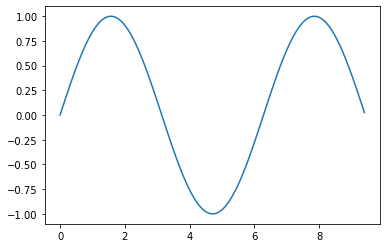
if we want to customize plots it is better to plot by first defining fig and ax objecs which have manuy methods for customizing figure resolution and plot related aspects respecticely.
fig, ax = plt.subplots()
y_sin = np.sin(x)
y_cos = np.cos(x)
# Plot the points using matplotlib
ax.plot(x, y_sin)
ax.plot(x, y_cos)
# Specify labels
ax.set_xlabel('x axis label')
ax.set_ylabel('y axis label')
ax.set_title('Sine and Cosine')
ax.legend(['Sine', 'Cosine'])
#fig.savefig("myfig.pdf")
<matplotlib.legend.Legend at 0x16aefb670>
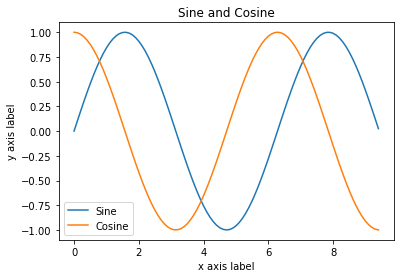
A gallery of useful examples#
For a greater variety of plotting examples check out Matploltib Gallery!
1D plotting is conveniently done by creating fig and ax objects which allow coutom styling plots and figure properties separately.
fig, ax = plt.subplots() # Create fig and ax objects
t = np.arange(0.0, 2*np.pi, 0.1) # create x values via np.arange or np.linspace
s = np.sin(t) # create y values
ax.plot(t, s, '-o') # make the plot
#fig.savefig('myFIG.png') # save figure
[<matplotlib.lines.Line2D at 0x16af80670>]
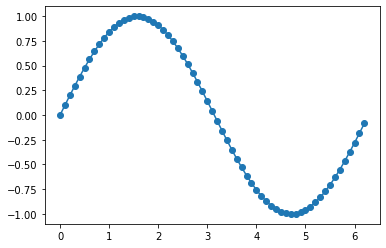
fig and ax objects#
For customizing plots it is more convenient to define fig and ax objects. One can then use ax object to make veriety of subplots then use fig to save the entire figure as one pdf. Try changing fig size, number of columns and rows.
t = np.arange(0.0, 2*np.pi, 0.1) # create x values
s = np.sin(t) # create y values
fig, ax = plt.subplots(nrows=1,ncols=2,figsize=(6,3))
ax[0].plot(t, s,'-o', color='purple', lw=1.0) # plot on subplot-1
ax[1].plot(t, s**2,'-o', color='green', lw=1.0) # plot on subplot-2
#fig.savefig('sd.png') # save the figure
[<matplotlib.lines.Line2D at 0x16b028970>]
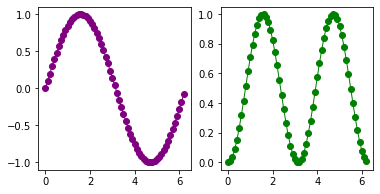
Plotting in 2D#
To make 2D plots we need to generate 2D grid \((x,y)\) of points and pass it to our function \(f(x,y)\)
x = np.arange(0.0, 2*np.pi, 0.1) # create x values
y = np.arange(0.0, 2*np.pi, 0.1) # create y values
X, Y = np.meshgrid(x,y) # tunring 1D array into 2D grids of x and y values
Z = np.sin(X) * np.cos(Y) # feed 2D grids to our 2D function f(x,y)
fig, ax = plt.subplots() # Create fig and ax objects
ax.pcolor(X, Y, Z,cmap='RdBu') # plot
# try also ax.contour, ax.contourf
<matplotlib.collections.PolyCollection at 0x16b04b850>
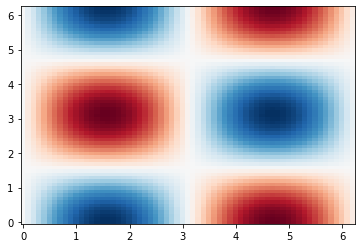
For 3D plot we will be using a powerful interactive library called plotly-express
import plotly.express as px
px.surface(x=X, y=Y, z=Z)
Plotting histograms and distributions#
# Make up some random data
mu, sigma = 100, 15
x = mu + sigma * np.random.randn(10000)
# Plot 1D histogram of the data
plt.hist(x, bins=40, density=True);
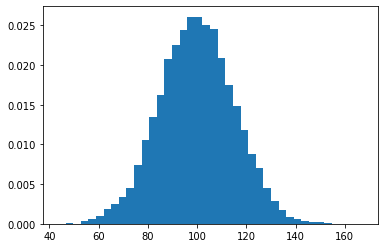
Seaborn library is especially powerful for visualizing statistical plots.
Seaborn is is a higher level library build on top of matplotlib that simplifies many intermediate steps that are needed to go from data to beautiful and polished visualization
import seaborn as sns
sns.displot(x, kind="kde")
# Make up some random data
mu, sigma = 100, 15
x = mu + sigma * np.random.randn(10000)
y = mu + 2*sigma * np.random.randn(10000)
# Plot 2D histogram of the data
plt.hist2d(x, y, bins=40, density=True, cmap='RdBu_r');
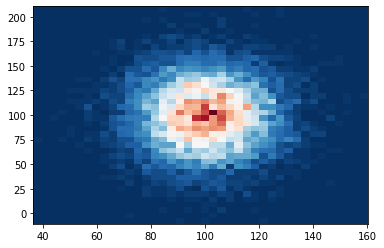
Let us plot the same using seaborn now. Notice that when plotting with seaborn we pass on x and y explicitely
sns.kdeplot(x=x,
y=y,
hue="kind",
fill=True)
Widgets#
Suppose we would like to explore how the variation of parameter \(\lambda\) affects the following function of a standing wave:
Make a python-function which creates a plot as a function of a parameter(s) of interest.
Add an interactive widget on top to vary the parameter.
from ipywidgets import interact, interactive
def plot_wave(phase, freq):
x = np.linspace(0,10,1000)
y = np.sin(freq*x+phase)
plt.plot(x, y)
interactive(plot_wave,
phase=(0,2*np.pi),
freq=(0.1,5))
Additional resoruces.#
Matplotlib has a huge scientific user base. This means that you can always find a good working template of any kind of visualization which you want to make. With basic understanding of matplotlib and some solid googling skills you can go very far. Here are some additional resources that you may find helpful

